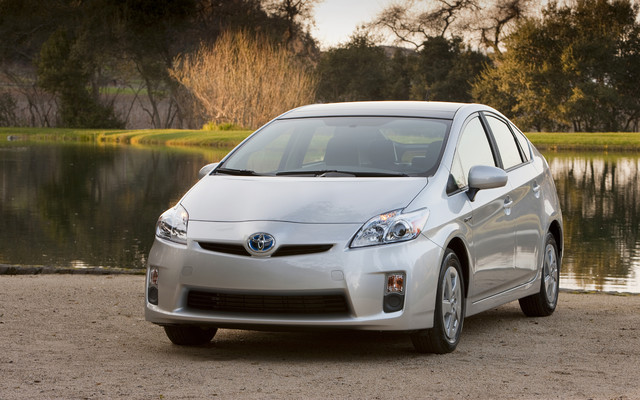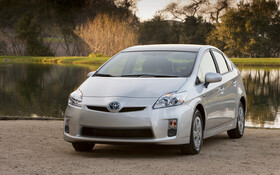2010 Prius: Less Pump, More Pleasing

| Strong points |
|
|---|---|
| Weak points |
|
As an automotive journalist, you have good times, and bad times. Good times usually encapsulate weeks and months filled with sporty coupes and capable four-wheel drives, while the bad times... well, those are the weeks and months spent driving the cars people actually buy.
Which brings us to this: the Toyota Prius. Having cornered the hybrid-specific market for what feels like a lifetime, Toyota’s been pumping out the diminutive gas-sipping sedans for everyone from taxi drivers, to Hollywood starlets to eco-aware soccer mom’s the world over. Currently standing as the benchmark by which all other economical vehicles are measured, its singlehandedly brought Toyota to the perceived forefront of the hybrid marketplace.
And it’s also about as exciting to the average human being as a Leaf’s game. But, like the infamous failure of a hockey team hailing from the center of the universe, we can’t seem to stop hearing about the Prius. Day in and day out, you see them trundling silently about their business while your television set extols the virtues of environmentally friendly driving by illustrating that, should you buy a Prius, you too may end up wearing a goofy looking permagrin and a woollen knit sweater to match. Puppies will love you, women will be attracted to your obvious environmentally sensitive side, and grass will spring up in your footsteps. Even on cement.
But the truth may not be so rosy. The fact remains; hidden in the bowels of each and every one of these environmentally friendly vehicles is a massive vat of refined chemicals. Hailing from around the world, these chemicals are among some of the most toxic in the world, and the sum total of energy consumed and the resultant pollution created during the manufacture of a Prius’ battery cell can be understood to nearly negate any positive environmental impact the dual-mode hybrid system may impart. That said, the only way to truly protest the consumerist nature of the automotive industry is to spurn the internal combustion entirely, which leaves you with but a few options, none of which are attractive.
So, while you may not be saving the environment by purchasing a Prius, you may be saving yourself a while whackload of money. Because although it might not be as environmentally friendly as saving a would-be 4,000 pound trash heap from the ridiculous cash for clunkers programs, it definitely boasts significantly better fuel mileage. With absurdly low EPA averages, the dual mode system is simply stellar in real-world conditions. While the original Prius and the subsequent second generations excelled in inner city traffic, but suffered slightly (by comparison) on long highway jaunts. Interestingly, Toyota’s fixed that in a relatively surprising way: by fitting a larger engine. With a combined EPA average of 50 miles per gallon, the 2010 model boasts a larger, more powerful Atkinson-cycle engine. Now displacing 1.8 litres, the four cylinder gasoline-burning engine produces just 89 horsepower. That low power output means the new motor is under nearly no strain, and sips gas while churning away at highway speeds. At lower speeds, the electric motors kick in to provide the Prius with 134 horsepower in total. For those keeping score at home, that’s an improvement of 24 horsepower and 6 miles per gallon combined.
How? By reconsidering absolutely everything. First, the standard water pump has been tossed out in favour of an electric example; reducing lost power. Interestingly, that, combined with the unique electric system of the hybrid, means this is the first Toyota without an accessory drive belt on the front of the engine. Furthermore, the new transaxle is lighter and substantially reengineered to reduce torque loss by up to 20%.
Of course, none of this would amount to squat if it wasn’t for Toyota’s attempts at altering the single most important part of the new Prius: the driver. And like the current crop of hybrids, the Prius offers a few feedback systems to keep drivers operating their Prius in the most economical manner possible. That includes four driving modes (Power, Eco, EV, and Normal) that are driver-selectable, and a plethora of gauges and readouts.
Which brings us to the interior. For Prius fans, it will appear familiar. The starship Enterprise-Inspired look is still there, as is the bizarre little shifter. Overall, it’s a comfortable place to be, with an expansive greenhouse and good ergonomics. Of course, that doesn’t need to be said, given the Prius is a Toyota product. There’s a ton of soft-touch surfaces, and the dashboard has a unique texture that’s both interesting and glare-reducing. However, the oval steering wheel is something of an oddity in the relatively staid interior, and probably won’t be to everyone’s taste. Then again, neither will the centered instrument cluster. But for practicality’s sake, the centralized instrument cluster does a good job of keeping everything in a single location while simultaneously offering a better view over the hood that’s unimpeded by a binnacle.
Moving down the road, the Prius behaves exactly as expected. To call it boring might be going too far... or then again maybe not. But, with low-rolling resistance tires fitted at all four corners and a suspension system designed for comfort, it’s not expected to be anything beyond practical, and in that regard it excels. Over nearly every road surface, the Prius covers the ground without ruffling a feather, maintaining a quiet decorum in the cabin. Throttle response is dismal is eco mode and surprisingly potent in power mode, although the powerband falls off quickly as the revs range.
In short, the 2010 Prius is basically exactly the same as the last one... albeit more so. In other words, if you liked the last one, you’ll probably like this one too. It’s a great people mover that won’t hurt you in the wallet, and offers more space than the cheaper Honda Insight. The fuel economy is amazing, and the hybrid synergy drive’s intrusion is all but nonexistent in the driving experience. But, while the Prius may have earned its reputation as the best selling hybrid in an otherwise barren marketplace, the hybrid environment has changed dramatically. Ford’s excellent Fusion offers up arguably more practicality for a slight trade-off in fuel consumption, and the upcoming Chevy Volt is perhaps most anticipated vehicle of this ilk ever. How will the updated Prius fare in the coming years? Well, only time will tell.











